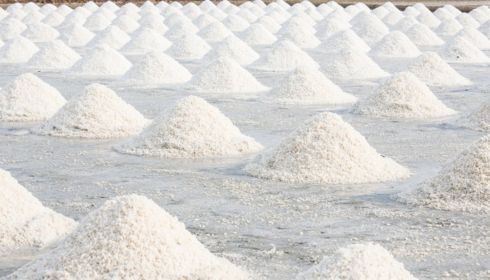There’s something kind of magical about simple things that do a big job without making a scene. Solar salt is one of those quiet workhorses. It’s not glamorous, doesn’t sparkle on a shelf, and most people don’t even think about it until they’re hunched over their water softener wondering, “Am I using the right stuff?” If you’ve ever squinted at a salt bag wondering what sets it apart—or why your softener’s acting up—this little deep dive into solar salt might clear a few things up.
The Basics: What Is Solar Salt, Really?
Let’s keep this simple. What is solar salt? It’s salt—yes, good old sodium chloride—but not the kind that’s dug up from underground mines or chemically refined in factories. Solar salt is made through a natural evaporation process where seawater is captured in shallow ponds, left to bask in the sun, and slowly dries out under heat and breeze.
The result is a coarse, white crystal that’s about as pure as salt can get without being overly processed. No chemicals, no blasting, no drama. Just sun, wind, and time. Kinda poetic, if you think about it.
But It’s Not for French Fries
This isn’t your fancy Himalayan pink or flaky finishing salt. Solar salt is mostly used for practical stuff—like water softening, de-icing, and even in some industrial applications. It’s clean-burning, dissolves well, and doesn’t come with the gunky residue that you might get from other salts.
Its purity makes it ideal for water treatment systems, especially if you’re trying to keep that brine tank from turning into a crusty science experiment. The less “extra” stuff in the salt, the smoother everything runs.
Understanding the Family Tree: Solar Rock Salt, Solar Crystals, and More
Now, don’t confuse solar salt with solar rock salt—even though they sound like siblings. Rock salt is typically mined from the earth, usually less refined, and often contains more impurities. That doesn’t mean it’s bad; it just might not be the best pick if you’re looking to minimize sludge and scaling in your system.
Solar salt, by contrast, is more consistent in purity and dissolves better. If you live in an area with extremely hard water, that clean dissolving nature matters. No one wants to deal with a salt bridge or a blocked injector.
And then you’ve got solar salt pellets, solar crystals, even solar blocks. The form you choose usually comes down to your softener’s preferences and your willingness to do occasional maintenance. Crystals tend to be more budget-friendly but may clump in humid climates. Pellets are pricier, but they resist bridging better.
Solar Salt for Water Softener Systems: Why It’s a Smart Choice
Okay, let’s talk performance.
When your water softener does its thing—swapping hard minerals like calcium and magnesium with sodium ions—it needs a steady supply of salt to recharge the resin beads inside the tank. If that salt isn’t dissolving efficiently or is full of insoluble junk, your softener has to work harder, and your water may still feel… kinda hard.
That’s where solar salt for water softener units shines. It’s often purer than alternatives like rock salt and tends to leave fewer deposits in your system. Less cleaning, fewer clogs, longer lifespan for your equipment. It’s one of those small decisions that pays off over time.
Signs You’re Using the Wrong Salt (Or Not Enough of It)
Ever noticed a ring of soap scum forming in your tub again after months of soft, silky water? That might be your softener telling you something’s up.
If your brine tank has a solid crust forming across the top, you’re dealing with a salt bridge—usually caused by low-quality salt or poor ventilation. If there’s sludgy muck at the bottom, it could be excess impurities.
And if your water starts feeling rough, your laundry’s not rinsing clean, or you’re spotting scale on your fixtures again… chances are your softener isn’t regenerating properly.
Switching to a cleaner salt like solar might just be the simple fix you didn’t know you needed.
Sustainability Angle: Gentle on the Planet, Too
You know what’s cool? Solar salt doesn’t require bulldozers, deep mining shafts, or energy-intensive chemical processing. It just needs nature.
By harnessing solar evaporation, manufacturers can create a highly effective product with a relatively low environmental impact. That’s good news for anyone trying to cut down on their household’s carbon footprint without sacrificing function.
So if you’re the type who shops organic or switches off lights obsessively—solar salt fits the vibe.
How to Use It (And How Not To)
One of the perks of solar salt is that it’s low-maintenance. But there are still a few things worth knowing:
- Read your manual: Not all softeners are built the same. Some may prefer pellets over crystals. Some don’t like fine grains. Don’t guess—check.
- Keep it dry: Store solar salt in a cool, dry place. Humidity is its enemy, leading to clumping and messy pours.
- Clean your tank: Even with high-purity salt, it’s smart to flush out your tank once a year. A little upkeep now can prevent major issues later.
Real-World Tip: Buy in Bulk, Store Smart
Salt doesn’t go bad. If you’ve got the space, buying in bulk saves you money in the long run. Just be sure to keep it off the ground, sealed tight, and out of damp garages.
Also, check your local hardware or farm supply store—they often carry better prices on large bags than big box retailers. You’d be surprised how much savings add up over a year.
So, Should You Be Using Solar Salt?
Here’s the thing: if your water softener is struggling, or if you’re sick of cleaning it every few months, upgrading to solar salt might be the least expensive “fix” you can make. It doesn’t cost a fortune. It’s easier on your system. And it’s widely available.
Is it perfect for everyone? Maybe not. But for most households, especially in areas with moderately to heavily hard water, it makes a ton of sense.
If you’re into low-fuss, effective, and eco-conscious choices—solar salt is worth a spot on your shopping list.
Final Thoughts: Small Crystals, Big Impact
Water softening is one of those modern conveniences that makes life a whole lot better—but it’s easy to forget it needs the right fuel to run right. Solar salt isn’t some trendy upgrade or overhyped gadget. It’s old-school, reliable, and works quietly behind the scenes.

